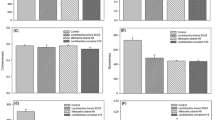Abstract
A sour kimchi product with an elevated amount of γ-aminobutyric acid (GABA) was produced using starter lactic acid bacteria (LAB) for mukeunjee kimchi fermentation. The starter LAB were screened and isolated from the commercial mukeunjee kimchi product that showed the highest GABA content and was identified as Lactobacillus buchneri. The maximum GABA production of L. buchneri in MRS media was 5.83 mg/mL at pH 4.2 and the addition of 3% NaCl did not significantly (p>0.05) changed GABA production of L. buchneri. The amount of GABA in L. buchneri-inoculated sour kimchi was 61.65 mg/100 g, which represented about 8 times higher than the L. buchneri uninoculated kimchi (control kimchi). A sensory evaluation test of L. buchneri-inoculated sour kimchi and control kimchi showed that the L. buchneri inoculation may produce more sour kimchi than control kimchi, but there was no difference in the general acceptance between the 2 kimchi products (p>0.05).
Similar content being viewed by others
References
Codex Alimentarius. Codex standard for kimchi (CODEX STAN 223-2001). In: FAO/WHO Joint Publications: Processed and Quick Frozen Fruits & Vegetables. 5A (2001)
Cheigh HS, Park KY. Biochemical, microbiological, and nutritional aspects of kimchi (Korean fermented vegetable products). Crit. Rev. Food Sci. 34: 175–203 (1994)
Cho J, Lee D, Yang C, Jeon J, Kim J, Han H. Microbial population dynamics of kimchi, a fermented cabbage product. FEMS Microbiol. Lett. 257: 262–267 (2006)
Lee CW, Ko CY, Ha DM. Microfloral changes of the lactic acid bacteria during kimchi fermentation and identification of the isolates. Korean J. Appl. Microbiol. Biotechnol. 20: 102–109 (1992)
Higuchi T, Hayashi H, Abe K. Exchange of glutamate and γ-aminobutyrate in a Lactobacillus strain. J. Bacteriol. 179: 3362–3364 (1997)
Jakobs C, Jaeken J, Gibson KM. Inherited disorders of GABA metabolism. J. Inherit. Metab. Dis. 16: 704–715 (1993)
Wong CGT, Bottiglieri T, Snead OC. GABA, γ-hydroxybutyric acid, and neurological disease. Ann. Neurol. 54: S3–S12 (2003)
Ueno H. Enzymatic and structural aspects on glutamate decarboxylase. J. Mol. Catal. B-Enzym. 10: 67–79 (2000)
Oh SH, Moon YJ, Oh CH. γ-Aminobutyric acid (GABA) content of selected uncooked foods. J. Food Sci. Nutr. 8: 75–78 (2003)
Siragusa S, De Angelis M, Di Cagno R, Rizzello CG, Coda R, Gobbetti M. Synthesis of γ-aminobutyric acid by lactic acid bacteria isolated from a variety of Italian cheeses. Appl. Environ. Microb. 73: 7283–7290 (2007)
Kim JY, Lee MY, Ji GE, Lee YS, Hwang KT. Production of γ-aminobutyric acid in black raspberry juice during fermentation by Lactobacillus brevis GABA100. Int. J. Food Microbiol. 130: 12–16 (2009)
Park KB, Oh SH. Production of yogurt with enhanced levels of γ-aminobutyric acid and valuable nutrients using lactic acid bacteria and germinated soybean extract. Bioresource Technol. 98: 1675–1679 (2007)
Cho YR, Chang JY, Chang HC. Production of γ-aminobutyric acid (GABA) by Lactobacillus buchneri isolated from kimchi and its neuroprotective effect on neuronal cells. J. Microbiol. Biotechn. 17: 104–109 (2007)
Seok JH, Park KB, Kim YH, Bae MO, Lee MK, Oh SH. Production and characterization of kimchi with enhanced levels of γ-aminobutyric acid. Food Sci. Biotechnol. 17: 940–946 (2008)
Chin HS, Breidt F, Fleming HP, Shin WC, Yoon SS. Identifications of predominant bacterial isolates from the fermenting kimchi using ITS-PCR and partial 16S rDNA sequence analyses. J. Microbiol. Biotechn. 16: 68–76 (2006)
Zook K, Wessman C. The selection and use of judges for descriptive panels. Food Technol. -Chicago 31: 56–61 (1977)
Lee JS, Heo GY, Lee JW, Oh YJ, Park JA, Park YH, Pyun YR, Ahn JS. Analysis of kimchi microflora using denaturing gradient gel electrophoresis. Int. J. Food Microbiol. 102: 143–150 (2005)
Kim SH, Shin BH, Kim YH, Nam SW, Jeon SJ. Cloning and expression of a full-length glutamate decarboxylase gene from Lactobacillus brevis BH2. Biotechnol. Bioproc. E. 12: 707–712 (2007)
Choi SI, Lee JW, Park SM, Lee MY, Ji GE, Park MS, Heo TR. Improvement of γ-aminobutyric acid (GABA) production using cell entrapment of Lactobacillus brevis GABA 057. J. Microbiol. Biotechn. 16: 562–568 (2006)
Yoo MJ, Kim HR, Chung HJ. Changes in physicochemical and microbiological properties in low-temperature and long-term fermented kimchi during fermentation. Korean J. Diet. Culture 16: 431–441 (2001)
Son SM, Park YS, Lim HJ, Kim SB, Jeong Y-S. Sodium intakes of Korean adults with 24-hour urine analysis and dish frequency questionnaire and comparison of sodium intakes according to the regional area and dish group. Korean J. Commun. Nutr. 12: 545–558 (2007)
Author information
Authors and Affiliations
Corresponding author
Rights and permissions
About this article
Cite this article
Cho, S.Y., Park, M.J., Kim, K.M. et al. Production of high γ-aminobutyric acid (GABA) sour kimchi using lactic acid bacteria isolated from mukeunjee kimchi. Food Sci Biotechnol 20, 403–408 (2011). https://doi.org/10.1007/s10068-011-0057-y
Received:
Revised:
Accepted:
Published:
Issue Date:
DOI: https://doi.org/10.1007/s10068-011-0057-y




